PAST ISSUES
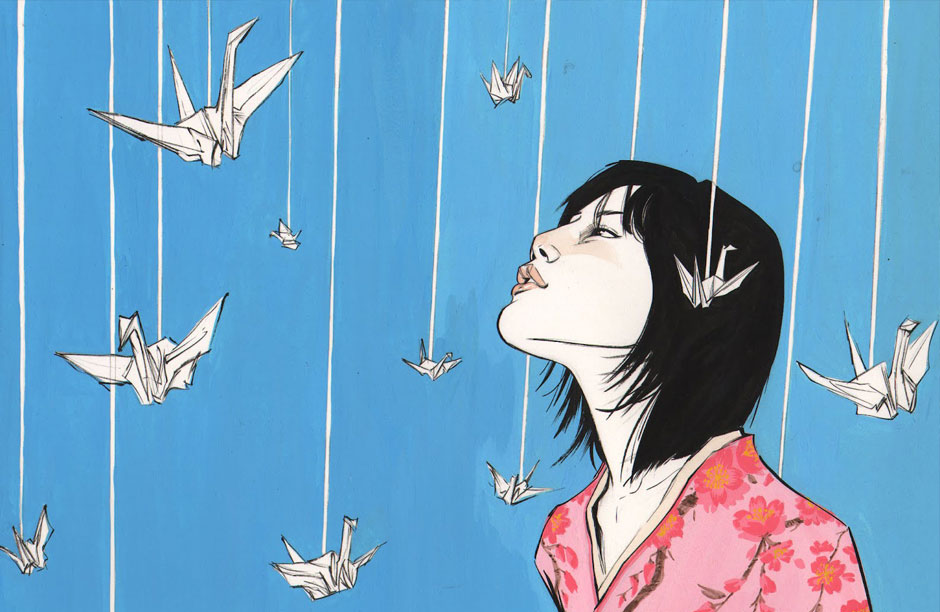 Portrait of Sadako Sasaki - a young girl who became the symbol of the innocent lives lost in the bombings of Nagasaki and Hiroshima and to the brutalities of World War II. Artwork by Joëlle Jones.
Portrait of Sadako Sasaki - a young girl who became the symbol of the innocent lives lost in the bombings of Nagasaki and Hiroshima and to the brutalities of World War II. Artwork by Joëlle Jones.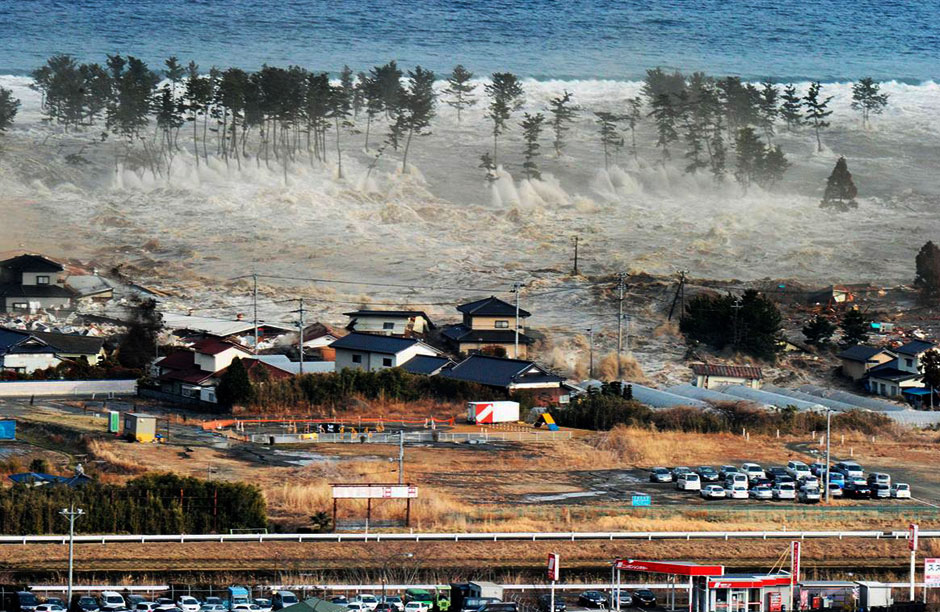 The dark surrealism of the March 2011 earthquake and tsunami in Japan echoed for many the devastation of the bombing of Hiroshima.
The dark surrealism of the March 2011 earthquake and tsunami in Japan echoed for many the devastation of the bombing of Hiroshima.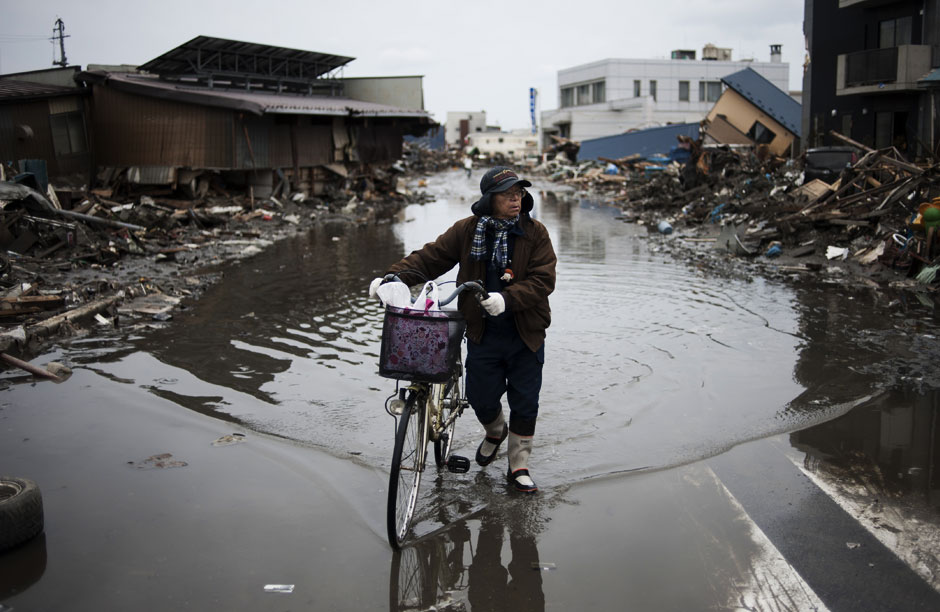 Another stark image from the 2011 Earthquake in Japan.
Another stark image from the 2011 Earthquake in Japan.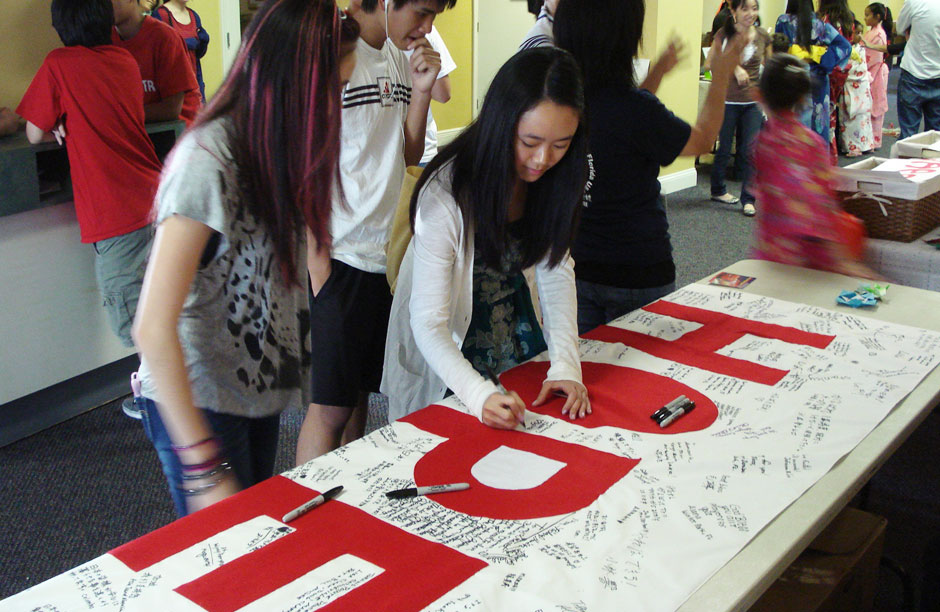 Sylvia Lai (at center), a freshman in college at the time of the earthquake in Japan, began spreading hope by taking action. She found inspiration in the story of Sadako Sasaki and her paper cranes.
Sylvia Lai (at center), a freshman in college at the time of the earthquake in Japan, began spreading hope by taking action. She found inspiration in the story of Sadako Sasaki and her paper cranes.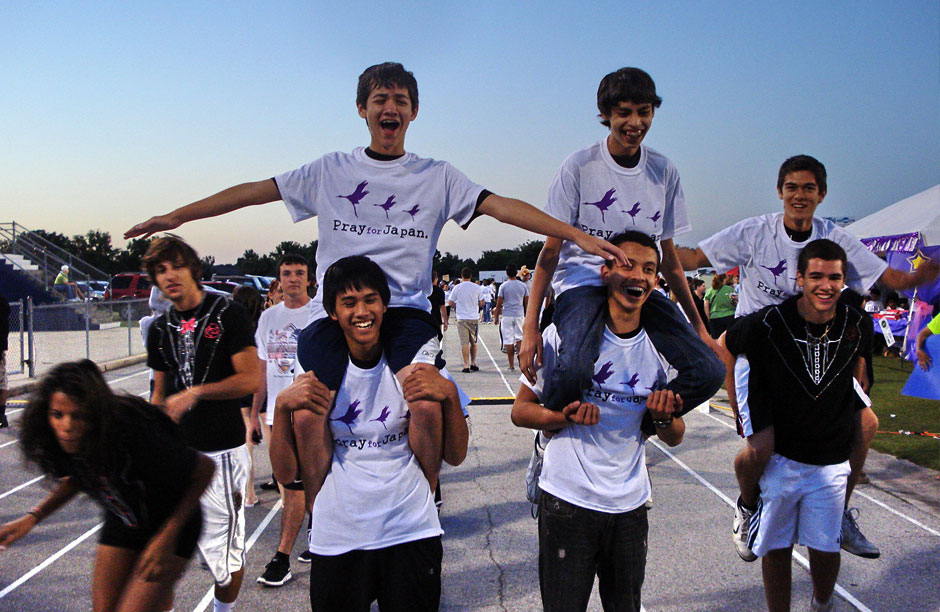 Sylvia's "Wish Upon A Crane" movement reached schools and communities around the country.
Sylvia's "Wish Upon A Crane" movement reached schools and communities around the country.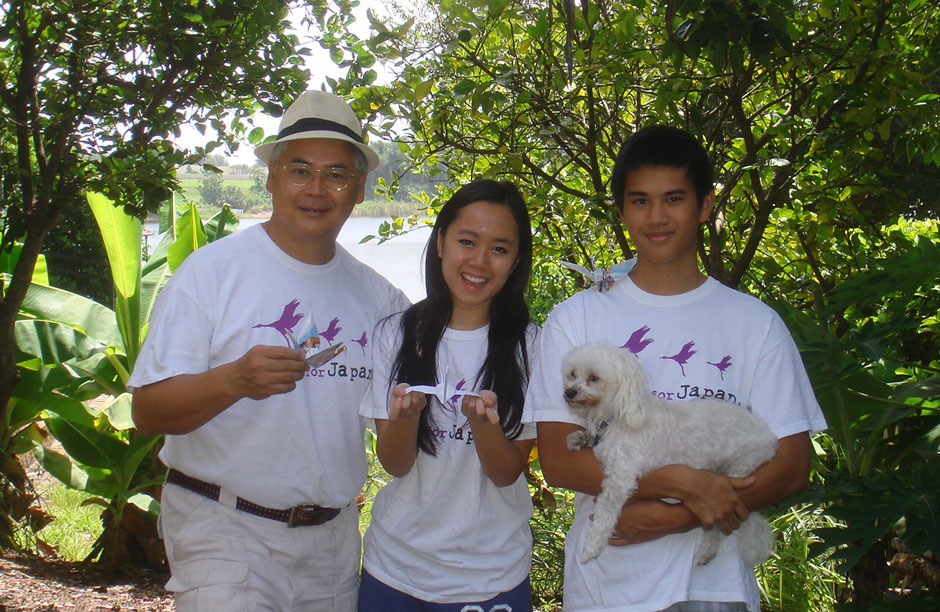 A Family Affair: Sylvia and her family came together as a team to get Wish Upon A Crane off the ground. From left, Waiyan Lai (Sylvia's Father and Advisor of Wish Upon A Crane Foundation), Sylvia Lai (Founder) and her brother Kevin Lai (co-founder). Her mother Eva Lai is also an Advisor.
A Family Affair: Sylvia and her family came together as a team to get Wish Upon A Crane off the ground. From left, Waiyan Lai (Sylvia's Father and Advisor of Wish Upon A Crane Foundation), Sylvia Lai (Founder) and her brother Kevin Lai (co-founder). Her mother Eva Lai is also an Advisor.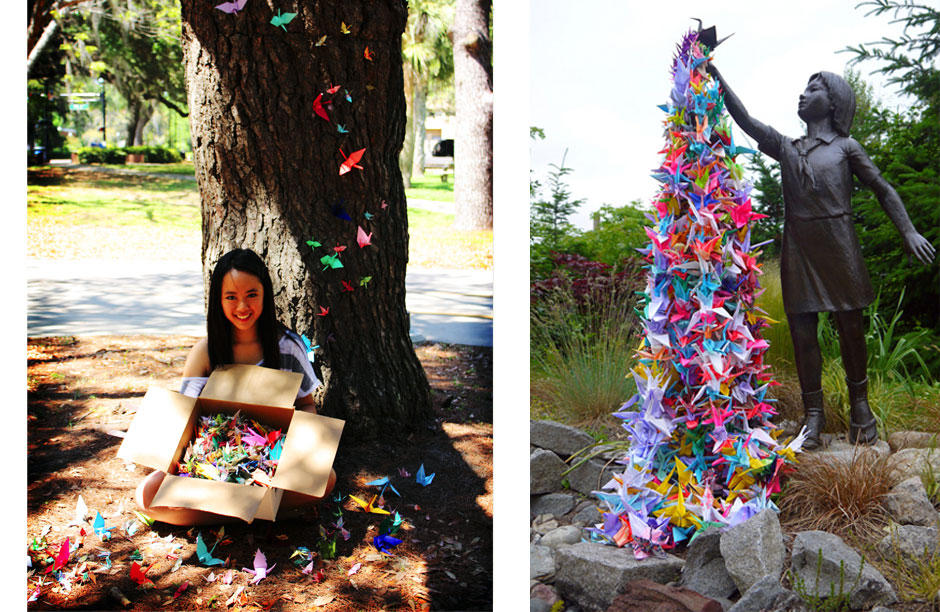 Sylvia Lai (left) and the statue of Sadako Sasaki (right) in Seattle's Peace Park where people come every August 6th - the anniversary of the bombing of Hiroshima - to hang paper cranes from Sadako's hand.
Sylvia Lai (left) and the statue of Sadako Sasaki (right) in Seattle's Peace Park where people come every August 6th - the anniversary of the bombing of Hiroshima - to hang paper cranes from Sadako's hand.
Wish Upon A Crane
By Johnny Blue StarCranes over Hiroshima, white and red and gold
Flicker in the sunlight like a million vanished souls
I will fold these cranes of paper to a thousand one by one
And I’ll fly away when I am done
– From Jim Small’s “Cranes over Hiroshima“
If you grew up in Japan, you grew up with the story of Sadako Sasaki. Like fairy tales and legends this story described unfathomable events, but the difference is that these events were real, the little girl was very real, and the ending unfortunately was not a happy one. Yet, the story of Sadako Sasaki has been passed from generation to generation as a tale of perseverance and hope and of the magic that comes from making a wish. On this anniversary of the bombing of Hiroshima 67 years ago we revisit the story of Sadako and another young girl who found a way to bring hope when Japan was devastated yet again in the 2011 earthquake.
The Story of Sadako Sasaki
She was so tiny, so delicate, her mother could hardly keep her eyes off her beautiful daughter Sadako, whose blissful sleep ignited a subtle glow in her heart. At that very moment of peace and tranquility the world suddenly erupted into a blinding flash of bluish white light as a torrent of exploding glass and smoke turned the room into a windstorm of rubble. Choking with fear, Sadako’s mother ran outside, madly crying for little Sadako. Then a miracle happened. She saw her tiny two-year old daughter on the ground just outside the window, waving her arms, bewildered, crying wretchedly, but alive. Sadako seemed all right until 1954, when the long shadow of radiation finally tore at the nine year old’s delicate body. Suddenly swellings formed and bulged slightly behind her ears and neck. A few months later, her legs were spotted purple. The doctors confirmed it was Leukemia. Sadako, kind and sweet, with a poetic sensitivity, had been sentenced to death by the dark cloud of Hiroshima. With a year to live, Sadako grasped for hope, which she found in the legend of the “white cranes”. According to the legend if you fold a thousand origami cranes you will be granted one wish. Sadako pillaged for scraps of paper, torn medicine labels, wrapping paper from gifts to make a thousand cranes, hoping to reverse the mushroom cloud’s fatal gift. Though there are various stories about whether or not she finished the cranes, it has been told that she only made it to 644 cranes, but upon her death her friends finished the remaining cranes and buried them with her to set her free. Sadako has now become an inspiration to thousands of Japanese children who make a pilgrimage each year carrying folded painted cranes to the Children’s Peace Monument in Hiroshima in memory of Sadako.
The Story of Sylvia Lai and The Wish Upon A Crane Foundation
On August 6th, 1945, at 8:15 AM, an atomic bomb was dropped over Hiroshima. Death was instantaneous for as many as 140,000 people. Children like Sadako, who survived, would not experience the effects until years afterwards. Fifty-six years later, on the Coast of Honshu, on March 11, 2011, Japan suffered another deadly nuclear attack, initiated by nature, but ultimately through the reactor meltdowns at Fukushima. Over 18,000 died in the 9.0 earthquake and devastating tsunami. According to a study by Stanford University, the danger of death through cancer to those in the infected area range from a small number to 1,300.
After Hiroshima, almost 250,000 would die later from radiation, burns and associated diseases. About 9% would linger to die of cancer and leukemia. The explosion in Unit 1 of Fukushima Daichi guaranteed the eventual release of iodine-131 and caesium-137, dangerous radioactive elements that can cause cancer. Eventually, the amount of cesium-137 released by the reactors would be 168 times the amount released in Hiroshima with radiation reaching as much as 500 times over safety limits and spreading over 230 square miles.
Sylvia Lai was in college when the earthquake and tsunami happened. She heard it first from her dad. She tried to read news articles on line, but got stuck. “I remember having a hard time even reading the news article as my mind kept going through all the Japanese friends I had, those who had relatives in Japan, or who were themselves living in Japan at the time. Then I saw the images on the news – images of rubble, destruction, and both lives and livelihoods lost forever.”
Sylvia wanted to do something, but she wasn’t sure how. “Suddenly an idea popped up and I knew that I had to make more people aware of this disaster – not just from sitting back and watching TV, but to be truly aware of the sufferings that are happening. I wanted to draw out people’s compassion and empathy to do something to help. I first heard about the story of Sadako when I was very little. In Asia, the story of the girl with a thousand paper cranes was like Snow White or Cinderella. It resonated with me. It was the ultimate story of hope, peace, and friendship – which was exactly what Japan needed after such a drastic natural disaster.”
Sylvia Lai continued to be riveted to the news reports online and on TV. “They were images depicting scenes as though straight from a Hollywood disaster movie – the ‘end of the world’ kind, where nothing and nobody is left. Except this tragedy was real and was worse. Much worse. The disaster, the pain, the deaths, everything was real and there was no rewind button… I knew that I had to make more people aware of this disaster – not just from sitting back and watching TV, but to be truly aware of the sufferings that are happening.”
Soon it was going to be Sylvia’s birthday. She had been promised a big party.
“When the disaster in Japan struck, I didn’t feel like celebrating when others had just experienced such tragedy. I decided that day I came up with Wish Upon A Crane, that I would do a birthday project every year that would give back to those in need because it simply made sense to me to help.” Her parents, Waiyin and Eva Lai, reacted strongly to the idea. “When Sylvia told us she wanted to do something to help tsunami victims instead of having a birthday party we felt such joy that is hard to describe.” Responding to her need, Kevin, her brother, joined her as co-founder. “I am pretty good with the computer and I use Facebook and other programs. I have many friends on FB and I decided to get them to spread the news of our activities.”
Sylvia adds, “Forming The Wish Upon a Crane Foundation certainly proved to be a new kind of challenge for me. Making a paper crane takes about a minute to fold, and to make sure I would reach a thousand cranes by my birthday, I folded cranes everywhere – walking to class, in class, whilst eating, on the bus, and just about during any spare time I had. In fact, in the days leading up to the fundraiser, I stayed up all night folding the paper cranes.”
But when she had trouble finding some volunteer help, a venue for her fundraiser and other activities, hope began to emerge. First, friends from her University joined her on a massive 1000 paper crane making session. Then, a Video Club helped her make a video about the Foundation and a how-to video on making paper cranes. A group of students wrote messages on the 700 cranes that were donated to the Northern Japan Relief Concert. They participated in the Relay for Life event at her old high school. An art student helped mastermind a Wish Upon A Crane photo shoot. Then, a cousin studying fashion design helped create their signature t-shirts, which said “Pray for Japan” on the front and promoted their Wish Upon A Crane website on the back. Shirts were given out I gave Wish Upon A Crane shirts out at ‘Trading Wise’ in Orlando, ‘Florida Food Service’ in Gainesville, and ‘Guest Associates’ in Alabama.” Ultimately, Sylvia chose the Red Cross as the recipient of the donations Wish Upon A Crane personally raised.
His parents, commenting on Kevin’s involvement, said, “This has a great impact on Kevin as well. He is more aware of things around him. We feel both of them will share with the world in the future. We can see him already turning “18” through his experience in helping his sister – but we will still plan a party for him and pray that the world is at peace on that day, not because of the party, but because it would mean another day of peace.”
Sylvia doesn’t slow down. She is currently an English/pre-law major at the University of Florida in Gainesville, Florida. At UF she is the Vice President of the “Keep A Child Alive” chapter, also produces a radio show for the blind at WUFT Radio Reading Service. She participates in the annual March of Dimes walk and at an annual event called “Project Makeover” in which students at UF help to renovate underprivileged elementary schools. After founding the Wish Upon A Crane Foundation, she is starting an eco-friendly clothing line and a reusable water bottle line.